|
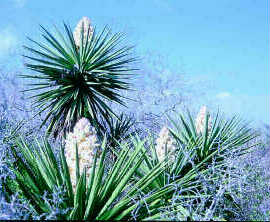
|
Native Shrubs |
|
of the Lower Rio Grande Valley, Texas
Landscape Uses and Identification
by the Native Plant Project
the online version
|
Acknowledgment
Shrubs
(A-Z)
An estimated 1,200 native flowering plant species grow in the
Lower Rio Grande Valley, Texas, and many of these species are
considered shrubs. A shrub differs from a tree in that they are
low growing, multi-stemmed woody plants usually not having a
single trunk. The Native Plant Project has selected some of the
most "ornamental" or "landscape appropriate"
shrubs from the numerous native species available to be featured
in this handbook. Most are beautiful ornamentals, some are even
valuable for wildlife use, but all make excellent landscape
plants.
Shrubs native to the Lower Rio Grande Valley have advantages
over shrubs brought in from elsewhere. Shrubs from this region
have the genetic factors which ensure greater probability for
survival. They are preadapted having evolved to tolerate local
climatic extremes, local soils, and local diseases and pests.
Most of these species are xeric-adapted. This means they require
little supplemental water, tolerate drought well, and conserve
much of the extra water which exotic shrubs require. Native
shrubs have evolved with temperature and rainfall extremes and
were relatively unharmed during the Christmas freezes of 1983 and
1989 which devastated the non-native plantings. A little extra
water though may greatly lengthen the flowering period of xeric-adapted
shrubs and trees.
Using native shrubs helps conserve rarer species which are
vanishing due to habitat clearing. Within the four-county (Cameron,
Hidalgo, Starr and Willacy) Lower Rio Grande Valley area over 98%
of the natural habitat has been converted or cleared for urban,
agricultural, or industrial use. Establishing rare species in
landscapings spreads out the individuals so one catastrophe
cannot take out a specie all at once and also provides an
alternative seed source in the event the last individuals of a
species are eradicated from natural habitat.
Some of our native shrubs are readily available from most
nurseries in the Lower Rio Grande Valley. Rarer ones can be found
only at the few nurseries specializing in Lower Rio Grande Valley
natives. (See list inserted in handbook.) More and different
native plants will become available if you demand them. The
Native Plant Project will provide sources upon request; the
availability of native shrubs changes as nurseries change their
available selections due to demand.
Founded in 1982, the Native Plant Project's purpose is to
protect and conserve the native plants (including endangered),
habitats and environment of the Lower Rio Grande Valley and
promote the use of local native plants in local landscapes. One
method it uses is disseminating information about native plants
and habitats. Its definition of a native plant is one indigenous
to the four-county area of the Lower Rio Grande Valley.
The Native Plant Project encourages the protection of native
plants through conserving and restoring native habitats in
refuges, natural areas in parks, wildlife management areas, and
private sanctuaries. It works to protect both natural habitat and
human-influenced environment. It encourages the conservation of
native species through inclusion in local landscapings. The
Native Plant Project works cooperatively with the U.S. Fish and
Wildlife Service, Texas Natural Heritage Program, Texas Parks and
Wildlife Department and many private organizations toward
protecting Endangered Species, including those local natives
imperiled but yet unlisted.
The Native Plant Project currently holds general meetings
eight times per year. Members are advised of meetings, field
trips, and other activities through The Sabal, which conveys
information on the native plants, habitats, and the environment
of the Lower Rio Grande Valley. The Native Plant Project
periodically updates and issues lists of endangered species of
the Lower Rio Grande Valley and checklists of its woody plants.
The choice of a native shrub, like any other plant, should be
dictated by landscaping need and the desired effect. Given the
limits of purpose and site, finding a native shrub which will
handsomely fulfill every requirement is no problem. Once a choice
is made, there remains only a few shrub location and planting
tips to be observed.
First, get your shrub from a reputable, reliable
nurseryman. DO NOT transplant from the wild, not only is this
rarely successful, it diminishes our threatened natural plant and
animal habitats. A healthy, vigorous looking small shrub is much
preferred over a large one, and smaller specimens suffer less
transplant shock. With smaller shrub's, chances of survival and
rapid growth are very high, they are cheaper, and within a year
their size equals those which were initially 2 to 3-times larger.
Second, most native shrubs do well on most Valley soils.
Poorly drained areas should be avoided or mounded for drainage
and the shrubs planted on top of the mound. Also many of our
native shrubs will grow on a site where a large portion of the
soil near the root area is covered by blacktop or paving. Make
sure the plant has plenty of growing space and not to plant
shrubs too close to houses or pathways.
The best times to plant in the Lower Rio Grande Valley
are late-autumn (to allow for root establishment and dormancy
before any freeze) and mid-February after danger of freezing has
passed. Planting during the hotter months can be done but
requires much more water, care and maintenance and is equally
more stressful on the plant and you than during the cooler late-autumn
through early-spring months.
A hole should be dug sufficiently deep and wide enough to hold
the full root system. In very poor soils it should be wider and
deeper. As the hole is dug, the soil from the top 4 to 6 inches,
which is richer should be kept separated from the subsoil.
Discard the subsoil and replace with the top soil or improve the
subsoil by mixing at least 1:1 subsoil to moist peat moss or
excess media from the pot in which the shrub was growing.
The depth of the top of the root system should NOT be lower
than the top of the hole, it usually kills the shrub when planted
too deep. Remove the shrub from the container. If roots are so
numerous they are encircling the soil ball, cut the root ball to
a depth of 2 inches with a sharp knife vertically to encourage
the roots to grow outward. After setting the shrub in the hole,
soil should be added gradually working the first lot in firmly at
the base of the root ball, then filling the hole with more soil.
The shrub may be raised and lowered during the filling process to
eliminate air pockets thus bringing the roots in closer contact
with the soil. When filled tamp the area firmly with your feet.
The soil around the shrub must be watered thoroughly
after the plant is set in place. A ring of soil at the perimeter
of the filled hole, 4 inches high, should be made for holding
water. The frequency of watering depends on the type of soil, the
size of the shrub and the amount of rainfall. The soil ball
around a newly planted shrub can dry out rapidly and Valley
showers cannot be depended upon to supply sufficient moisture
during the critical first year of growth. During mid-spring,
summer and mid-fall months water all newly planted shrubs for the
first 4 to 6 weeks as often as 3 times a week by filling to the
top of the soil ring (during the rest of the year a weekly
soaking over a 4-week period should be sufficient). Then every
two weeks thereafter for the first year, you should provide ample
moisture for your shrub to survive and grow. Then let nature do
the watering.
Shrub pruning may be necessary for a variety of reasons.
The method and timing can vary depending on the species, age, and
condition of the plant. The main reasons for pruning, aside from
wanting to create or maintain a rigid, formal appearance, are:
- to remove broken branches which resulted during planting.
- to remove dead branches, or to remove areas infested with
insects or disease.
- to correct or improve the shape; for example, a branch
may spoil the general balance of the plant, or may grow
into other plants or a pathway, or may cross other
branches on the same plant and shut out light and air to
the center of the plant.
Regular pruning is not necessary for most species, or
may not be needed at all. To achieve an irregular or informal
"natural" looking shrub or hedge which fits into every
landscape, except the most formal of designs, the cutting back of
individual branches should be done at various levels, removing
individual large, medium and small branches, thus creating a soft
appearance. Shearing off uniformly the outermost few inches of
growth creates a hard, formal outline of a trimmed hedge. REMEMBER when pruning make all cuts at the
base of a branch, i.e. at the branching point, leaving only a cut
flush with the remaining branch or a stub of less than 1/4 inch (6
mm). Pruning to achieve a "natural" look should be
carried out in three stages:
- Removal of large branches is to be made below the center
near the base of the shrub. The object being to shorten
the overall height of the plant and to open the center
for light penetration and air movement. Only one or two
such cuts are necessary. The branches removed are from
parts of the shrub which are the most crowded and where
their loss will be the least noticed. Also they will need
to be removed because they are unattractive, damaged or
diseased. Care should be given to cutting large branches
because their removal will dramatically alter the look of
the shrub.
- Removal of medium sized branches is made after the
removal of larger ones, to continue the opening of the
shrub for air and light penetration and to create
uniformity in shrub density; however, care should be
exercised to avoid drastic or too much pruning. The
overall look of the plant must be taken into account
during the pruning progress. Removing branches over the
entire shrub one by one and stepping back from the plant
to assess the overall effect of balance and density is
the best procedure.
- Removal of some of the growing tips is the final pruning
stage. This pruning removes only 1 to 3 inches (2 to 8 cm)
of growth and is used to continue the opening of the
shrub by effecting the overall density. The overall look
of the plant will be a soft, feathery appearance
resulting from the removal of growing tips here and there
over the entire shrub.
Remember the purpose of pruning, except for diseased or
damaged branches, is to control growth, and this process should
occur gradually throughout the year as opposed to severe pruning
once a year. Regular pruning throughout the year results in more
air and light penetrating the plant and, for Cenizo especially,
produces in leafy growth from the older wood, giving a fuller,
healthier, more attractive plant.
The best time for pruning depends upon the shrub, generally
after flowering and fruiting is completed. Shrubs that lose their
leaves, either in winter or during a drought, this is the best
time to prune as they are bare and it allows for the best
assessment of the shrub's overall shape and health problems, and
for ease in seeing where cuts are to be made. Otherwise, light
pruning to control growth throughout the year is acceptable.
Plant communities in the Lower Rio Grande Valley (LRGV) are
part of the South Texas (or Rio Grande) Plains which constitute
most of the Texas half of the Tamaulipan Biotic Province. The
entire Lower Rio Grande Valley lies on the Gulf Costal Plain
which extends across the LRGV and Rio Grande to the Sierra Madre
Oriental and its outliers. The western part of the LRGV (Falcon
Woodland) is also the easternmost part of the shrub-dominated
Chihuahuan Desert. Plains and brush land plants reach the LRGV
from the north and more eastern plants line the Rio Grande.
Several plants have disjunct Trans-Pecos and LRGV distributions.
Costal plants reach the LRGV from north and south. Subtropical
plants also lend their unique character to the LRGV's subtropical
appearance.
Water availability, soil type, and temperatures are the
predominant non-human determinants of the LRGV's unusually
varied and unique vegetational communities and habitats. Five
major vegetational areas include barrier islands, coastal,
riparian woodlands, shrublands (chaparrals), and sandplain
grassland. These five general areas each consists of many diverse
associations and habitats. The LRGV lacks perennial streams and
few historic springs survive.
The four-county LRGV is enclosed by the Gulf of Mexico on the
east, waterless Sand Plain containing La Sal Viejo and La Sal Del
Ray on the north, and an arbitrary (county) line on the west
between Flacon Reservoir (in the Chihuahuan Desert) and the Sand
Plain. The Bordas Scarp in Starr County is the major component of
relief. The Rio Grande (Rio Bravo) separates the Texan and the
Tamaulipan portions of the LRGV. The nonpolitical southern
boundary is another waterless area between the Rio Grande and the
Rio San Fernando. The area of Rio Grande Delta consists of the
floodplain broadening eastward, including Cameron, Willacy, and
southern Hidalgo Counties and a similar area in Tamaulipas.
The tree-life and water distribution somewhat characterize
these five areas. The barrier islands lack trees and the few
scattered shrubs never exceed one meter in height. The coastal
communities have a few stunted Texas Ebonies or Honey Mesquite
trees on holophytic shrub-covered lomas. Freezes permitting,
characteristic Black Mangroves shrubs grow near the coastal
brackish waters or marshes. The riparian woodlands and palm
jungles cover open or dense shrub layers which line the Rio
Grande and its resacas. The dry shrublands consists of short
trees and shrubs with taller trees around depressions and
potholes. The Sand Plain and its bordering habitat lack trees
except for isolated groupings surrounded by a sea of grass. Many
shrubs in western and northern LRGV can shed leaves during
drought stress and regrow them after rain.
Because of the little variation in temperature across the LRGV,
our trees and shrubs can be grown under a wide range of
conditions with only minor modification of site or care.
Riverbank-adapted plants require more water then will other
natives. Where necessary, this handbook includes such site
modifications in hope of improving success when planting one of
the LRGV native shrubs in your landscape.
|
TRECUL'S YUCCA, Palma Pita
Yucca treculeana - Agavaceae, Agave Family
Description: Woody trunk from spiny agave-form rosette,
with clusters of sharp-pointed leaves, dead leaves often hang as
skirt.
Height: To 25 ft., usually 6 to 12 ft.
Flowers: Small, creamy-white in clusters (panicles)
extending above foliage; late Winter - early Spring
Fruit: Reddish-brown, fleshy capsules drying woody
Foliage: Evergreen, simple, elongated leaves
Spines: Short, black spines at leaf tips
Bark: Dark-reddish-brown, thick with fissures and ridges
breaking into plates
Growth Rate: Fast (about 1 foot per year)
Requirements:
Sun: Full sun to partial shade, growing eventually above
surrounding shrubs
Soil: Many types
Drainage: Well-drained Water: Low, drought tolerant
Maintenance: None, if not planted near walkways
Propagation: Seeds, cuttings from rhizomes, stems or pups
Native Habitat: Clay lomas, chaparrals,
thornforest clearings, laguna isles
Wildlife Use:
Flowers - pollinating moths
Fruit - moth caterpillars
Nest sites - Northern Mockingbird, Curve-billed Thrasher, Gray
Hawk, Harris' Hawk, Cactus Wren
Leaves - White-tailed Deer, livestock Young trunks consumed by
Javalinas
Comments: Native people used every part of plant; roots
once used as soap; requires pronuba moths for pollination;
striking accent plant
|
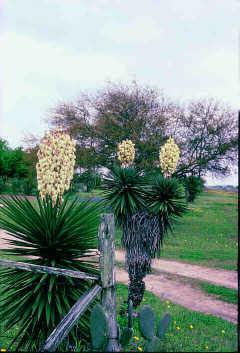
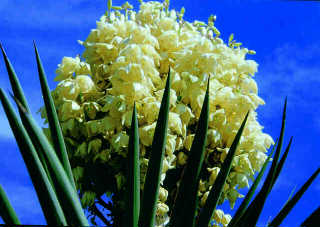
|
|
Mexican Trixis,
Hierba del Aire
Trixis inula - Asteraceae, Aster Family
Description: A weak-stemmed, much-branched, ascending
shrub
Height: 3 to 6 ft.
Flowers: Bright-yellow flowers in heads 0.8 inch wide
Fruit: Achenes with bristles (like dandelions)
Foliage: Simple, alternate, long oval, to 4 inches long, green
Spines: Unarmed
Bark: Straw-colored to brown
Growth Rate: Medium
Requirements:
Sun: Shade, partial sun
Soil: Loamy, well drained clay loams
Drainage: Well
Water: Low, drought tolerant
Maintenance: None
Propagation: Seed, semi-hardwood cuttings
Native Habitat: Thornforests, palm groves,
chaparrals
Wildlife Use: Leaves - White-tailed Deer
Comments: An attractive, unarmed shrub, flowering
through much of year
|
 |
Skeletonbush, [ none found ]
Viguiera stenoloba - Asteraceae, Aster Family
Description: Short, dense shrub with many yellow
sunflower-like flower heads
Height: To 3 ft
Flowers: Terminal heads with yellow ray and disk flowers; flowers
quickly after rainfall anytime of year
Fruit: Achene (like sunflower seed)
Foliage: Simple, alternate, drought-deciduous, narrow strip of
blade along midrib and a couple of skinny lobes
Spines: Unarmed
Bark: Gray, older stems develop narrow ridges and shallow
fissures
Growth Rate: Fast
Requirements:
Sun: Full
Soil: Sandy loam, caliche, gravelly
Drainage: Well
Water: Low, drought tolerant
Maintenance: Water increases flowering and leafing
Propagation: Seed, softwood cuttings
Native Habitat: Chaparral openings
Wildlife Use: Nectar - Butterflies Leaves -
Cattle and deer
Comments: One of the lower Rio Grande Valley's most
attractive shrubs to butterflies and human eyes
|
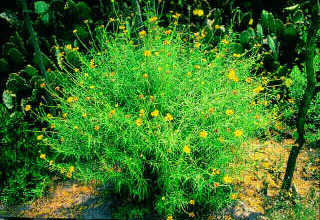 |
|
Nopal Prickly Pear, Nopal
Opuntia lindheimeri - Cactaceae, Cactus Family
Description: Large, erect to sprawling cactus with
flattened stems called pads or joints
Height: To 12 ft or more
Flowers: Large, 4 inches in diameter, usually yellow, also red,
salmon, or orange, from areoles; March-June
Fruit: Large, berry purple when ripe, from areoles
Foliage: Minute, deciduous, tenure brief, from areoles
Spines: Large, pale-yellow spines and tiny, yellow or brown ones
from areoles
Bark: Light-brown on trunks
Growth Rate: Fast
Requirements:
Sun: Prefers full sunshine, grows slowly in shade
Soil: Many, from sand to saline clay
Drainage: Well Water: Low, drought tolerant
Maintenance: None
Propagation: Seed, cut pad and plant
Native Habitat: Coastal sand dunes, clay lomas,
grasslands and savannahs, woodlands, thornforests, chaparrals, nopalerias, deserts
Wildlife Use:
Fruit - birds, mammals, Texas Tortoises, Coyotes
Pads - Southern Plains Wood Rats, Javalinas, cattle, White-tailed
Deer, Texas tortoise
Nest sites - Southern Plains Wood Rats, Cactus Wrens, Common
Ground-Doves, White-tipped Doves, Verdin
Water - from pads
Nectar - hummingbirds, butterflies, bees
Comments: Any dropped piece of pad grows into a new
plant; one of most valuable native plants for wildlife; still one
of most used for human food; national emblem of Mexico
|
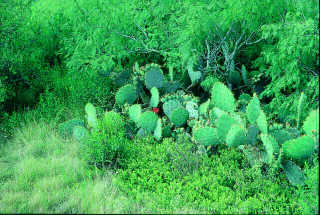
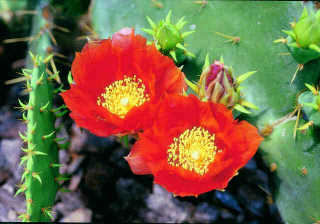
|
Mexican Caesalpinia,
Retamilla
Caesalpinia mexicana - Caesalpiniaceae, Caesalpinia Family
Description: Shrub to tree with green leaflets
contrasting with bright-yellow flowers and tan pods.
Height: To 30 ft, usually half that
Flowers: Many, small, bright-yellow flowers in clusters (racemes);
much of year
Fruit: Tan, inflated, oblong pods with light-brown seeds
Foliage: Alternate, leaflets dull-green above and paler beneath
Spines: Unarmed
Bark: Smooth, mottled, light or dark-gray, older trunks fissured
Growth Rate: Fast
Requirements:
Sun: Starts in partial shade, adapts to full sunshine
Soil: Various
Drainage: Medium
Water: Medium
Maintenance: Little
Propagation: Seeds
Native Habitat: Woodlands, thickets, open woods,
especially near resacas
Wildlife Use:
Flowers - butterflies
Leaves - caterpillars of Emesia Metalmark
Comments: One of the most popular native home
landscaping plants in lower Rio Grande Valley
|
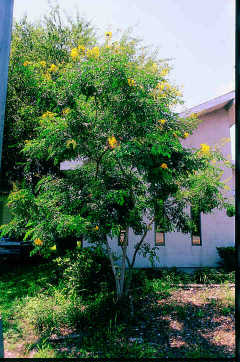

|
Desert Yaupon,
Capul
Schaefferia cuneifolia - Celastraceae, Staff-tree Family
Description: Intricately and densely branched shrub
with small leaves and orange fruit
Height: To 6 ft, usually 2 to 4 ft.
Flowers: Male and female flowers on separate plants;
inconspicuous, greenish to white, solitary or clustered in axils;
after rainfall throughout year
Fruit: Orange to bright-red, 2-seeded, little flesh
Foliage: Drought-deciduous, simple, alternate or clustered, pale-green,
sessile, wedge-shaped leaves
Spines: Unarmed Bark: New branches silvery-gray, older wood brown
to grayish-brown
Growth Rate: Slow
Requirements:
Sun: Full Soil: Gravelly, caliche, various
Drainage: Well
Water: Low Maintenance: Periodic pruning encourages compactness
Propagation: Seeds, cuttings, root sprouts
Native Habitat: Brushlands, chaparrals, gravely
hillsides
Wildlife Use:
Fruit - Northern Bobwhite, Scaled Quail, Cactus Wren, Coyote,
Southern Plains Wood Rat Nests in branches
Comments: Makes good hedges or specimen plants; the bright
fruit contrasts vividly with the green leaves Low
|
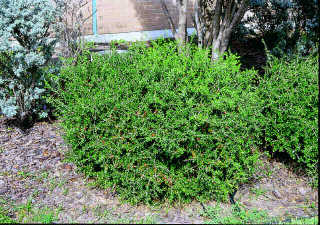
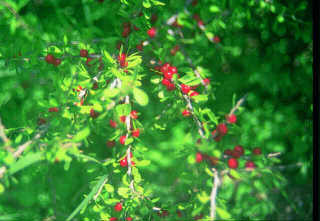
|
Low Croton,
Salvia
Croton humilis, Euphorbiaceae, Spurge Family
Description: Short shrub with oval leaves and white flowers
Height: To 3 ft rarely to 7 ft
Flowers: Unisexual on one plant or on separate plants, small, white, in clusters
(racemes); nearly all year after rains
Fruit: Globose capsules with 3 lobes and 3 seeds
Foliage: Simple, alternate, toothless, green, to 3.2 inches long Spines: Unarmed
Bark: Light-brown to pale-gray
Growth Rate: Slow
Requirements:
Sun: Shade Soil: Sandy, loamy, sandy clay
Drainage: Well
Water: Low, drought tolerant
Maintenance: None
Propagation: Seed
Native Habitat: Clearings in thornforests,
thickets, chaparrals
Wildlife Use:
Seed - Mourning Dove, White-tipped Dove, other doves and birds
Leaves - Tropical Leafwing
Flowers and Fruits - Gray Hairstreak caterpillars
Comments: Low Croton feeds hungry butterflies,
caterpillars, and seed-eating birds and pleases the human eye
|
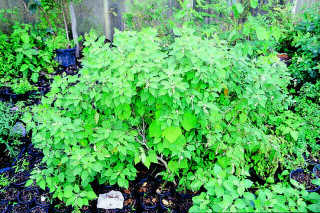
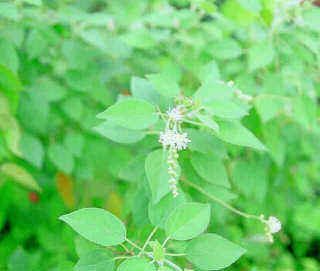
|
Torrey's Croton,
Salvia
Croton incanus, Euphorbiaceae, Spurge Family
Description: Tall, slender shrub with whitish, straight
branches, all parts covered with thick, short hairs
Height: Over 6 ft.
Flowers: Light-green, unisexual flowers in elongate clusters (racemes);
nearly all year after rainfall
Fruit: Three-lobed, oblong capsules, 0.25 inch long
Foliage: Simple, alternate, deciduous, oblong, to 2.4 inches,
gray-green above and pale beneath
Spines: Unarmed Bark: Gray and tomentose to smooth, gray, and
hairless later
Growth Rate: Medium
Requirements:
Sun: Partial shade, emerging into sunshine
Soil: Clayey, sandy, gravelly, caliche
Drainage: Well Water: Low, drought tolerant
Maintenance: None
Propagation: Seed
Native Habitat: Thickets, thornforest, chaparrals
Wildlife Use:
Seed - birds and small mammals
Leaves - caterpillars of Tropical Leafwing
Comments: Long known as Croton torreyanus
|
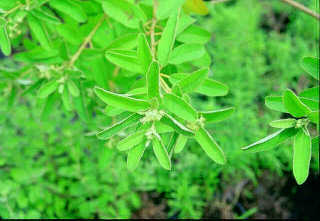 |
Texas Baby-Bonnets, (none found)
Coursetia axillaris, Fabaceae, Bean Family
Description: Rounded, densely-branched shrub with pink
flowers
Height: 5 to 7 ft.
Flowers: Pale-pink, solitary or few in axillary clusters (racemes),
primarily March with occasional reflowering later
Fruit: Reddish-brown, flat pods to 1.6 inches long, split open
and throw ripe seeds
Foliage: Alternate, 3 to 5 pairs of dull-green leaflets
Spines: Unarmed
Bark: Light to dark-gray, ashen
Growth Rate: Fast
Requirements:
Sun: Partial shade to full sun
Soil: Loamy, clayey; caliche ridge
Drainage: Well
Water: Low, drought tolerant
Maintenance: None
Propagation: Seeds
Native Habitat: Thornforest
Wildlife Use:
Seeds - several species of birds and mammals
Comments: Rare due to habitat loss, little is known about
plant
|
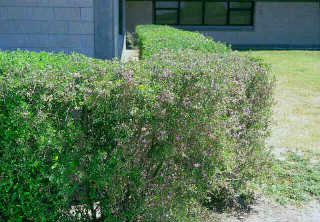
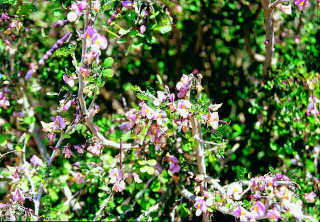
|
Texas Kidneywood,
Vara Dulce
Eysenhardtia texana, Fabaceae, Bean Family
Description: Much-branched, large shrub with small
leaflets and many fragrant white flowers
Height: 6 to 12 ft
Flowers: White, small (0.2 inch), numerous in slender, elongate
clusters (racemes); throughout year after rainfall
Fruit: Short, flat, one-seeded, brown pod, 0.4 inch long
Foliage: Alternate, drought-deciduous, many leaflets, dull-green
above, paler below, aroma distinctive
Spines: Unarmed
Bark: Light-gray and smooth, breaking into thin, elongate plates
with age
Growth Rate: Fast
Requirements:
Sun: Full sunshine, light shade
Soil: Sandy, caliche, gravelly
Drainage: Well
Water: Low, drought tolerant
Maintenance: None
Propagation: Seed, softwood cuttings
Native Habitat: Chaparrals
Wildlife Use:
Leaves - browsed by White-tailed Deer, livestock, caterpillars of
Mexican Dogface and Reakirt's Blue Fruit - doves, turkeys,
jackrabbits
Nectar - bees, butterflies
Comments: Flowered daily in Edinburg through drought
and freezes from Spring 1995 into 1997.
|
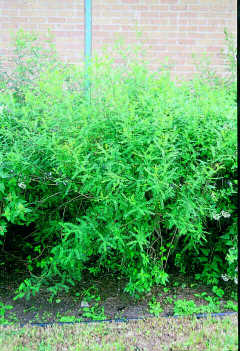
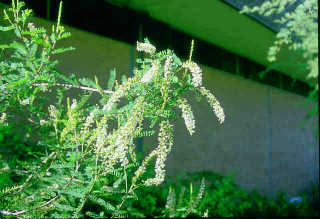
|
Coral Bean,
Colorin Erythrina herbacea var. arborea, Fabaceae, Bean Family
Description: Large, spiny-trunked shrub with large,
tubular, scarlet-red flowers at tips of rigid, ascending branches
Height: To 25 ft, usually 6 to 12 ft.
Flowers: Large, in terminal clusters (racemes), tubular, scarlet-red,
to 2.1 inches long
Fruit: Thin elongate, dark brown to black pods, open to expose
scarlet-red beans
Foliage: Alternate or clustered, leaflets 3, persistent, each
leaflet with 3 lobes; to 3.2 inches long
Spines: Stout, recurved thorns on trunk and branches Bark: Green
to reddish-brown, smooth
Growth Rate: Medium
Requirements:
Sun: Full sunshine to light shade
Soil: Loamy, sandy
Drainage: Medium
Water: Medium
Maintenance: Little
Propagation: Seed, cuttings, shoots from old roots, divisions of
root stalks
Native Habitat: Wooded edges
Wildlife Use:
Bark, stems, and beans poisonous to fish and wildlife
Flowers - hummingbirds
Comments: This very attractive shrub requires careful
placement to avoid contacting thorns
|
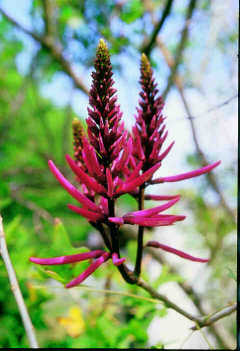
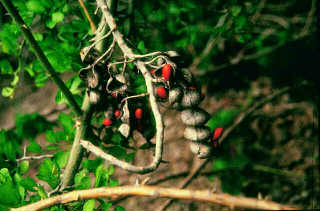
|
Yellow Sophora,
Tambalisa
Sophora tomentosa, Fabaceae, Bean Family
Description: Short, densely-pubescent, rounded shrub
Height: 3 to 6 ft
Flowers: Elongate, terminal clusters (racemes), bright-yellow or
yellowish-white; Spring to Fall
Fruit: Long, slender pod to 5 inches long, strongly constricted
between brow seeds
Foliage: Alternate, grayish leaflets, deciduous
Spines: Unarmed Bark: Green to light-brown Growth Rate: Medium
Requirements:
Sun: Full sun
Soil: Sand
Drainage: Well
Water: Low
Maintenance: None
Propagation: Seed
Native Habitat: Sand dunes
Wildlife Use: Lookout perches
Comments: Often tallest plant in sand dunes
|
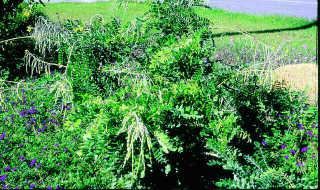
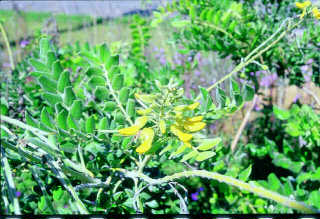
|
Brush - Holly,
Coronillo
Xylosma flexuosa, Flacourtiaceae, Flacourtia Family
Description: Evergreen, thorny shrub with olive-green
leaves and persistent red berries
Height: To 20 ft, usually 5 to 10 ft.
Flowers: Small, unisexual on same or separate plants, in axillary
clusters; at intervals throughout the year.
Fruit: Clusters of persistent, round, red 2 to 8 seeded berries
Foliage: Evergreen, simple, alternate or clustered, variably
sized, oval, olive-green or darker and paler beneath
Spines: Single, slender, straight spines of variable length Bark:
Smooth when immature, breaking into scales later, gray to brown.
Growth Rate: Slow to medium
Requirements:
Sun: Shade to full sun Soil: Various
Drainage: Well
Water: Low, drought tolerant
Maintenance: Little
Propagation: Seed, softwood cutting
Native Habitat: Palm groves, resaca banks,
brushy thickets, clay lomas
Wildlife Use:
Fruit - birds Comments: Attractive specimen shrub with
contrasting olive-green and persistent red to purple berries
|
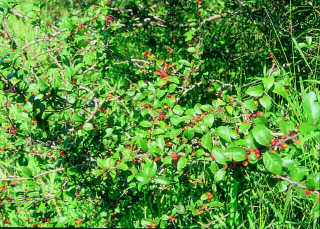
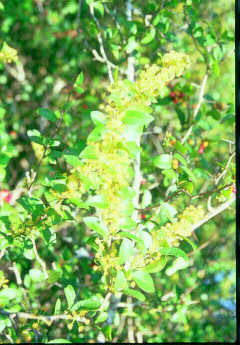
|
Shrubby Blue Sage, Mejorana
Salvia ballotiflora, Lamiaceae, Mint Family
Description: Aromatic leaves, much-branched, with many
attractive blue flowers after showers
Height: 5 to 8 ft
Flowers: Blue petals to 0.5 inch long, short clusters (racemes);
after rainfall anytime of year
Fruit: Four nutlets within folded, brown calyx
Foliage: Simple, opposite, oval, green leaves, variable in size
with moisture available, to 1.6 inch long, scent of crushed
leaves unique
Spines: Unarmed Bark: Gray to black, smooth on young stems
Growth Rate: Fast
Requirements:
Sun: Full, partial shade
Soil: Caliche, gravelly, sandy, sandy loam
Drainage: Well
Water: Low, drought tolerant
Maintenance: No fertilizing, too much fertilizer or water causes
it to grow leggy
Propagation: Seed, softwood and hardwood cuttings
Native Habitat: Brushy hillseeds, chaparrals,
thickets, brushlands, thornforests
Wildlife Use:
Nectar - butterflies
Leaves - Painted Lady caterpillars use some Salvias as cover
Comments: Very attractive
|
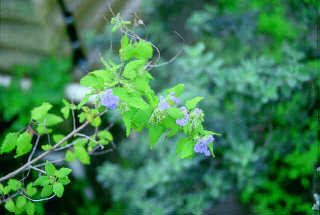 |
Hachinal, Willow-leafed Heimia
Heimia salicifolia, Lythraceae, Loosestrife Family
Description: Spreading, densely-branched shrub with
narrow leaves and bright-yellow flowers
Height: To 9 ft, usually half that
Flowers: Yellow bell-shaped, solitary, petals drop soon after
opening; Spring to Fall Fruit: Dry, brown, 4-celled capsule
Foliage: Simple, opposite, narrow
Spines: Unarmed Bark: Gray to brown
Growth Rate: Medium
Requirements:
Sun: Shade
Soil: Alluvial, clay
Drainage: Poor
Water: Medium
Maintenance: None
Propagation: Seed
Native Habitat: Resaca banks, riverbanks,
pothole margins
Wildlife Use: None known
Comments: Attractiveness diminished by quick drop of
petals
|
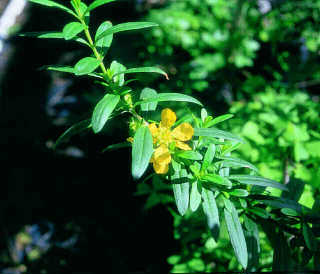 |
Manzanita, Acerola,
"Barbados Cherry"
Malpighia glabra, Malpighiaceae,
Malpighia Family
Description: A ground cover (especially if mowed),
shrub, hedge, or tree with dark-green leaves, pink flowers, and
red fruit
Height: To 20 ft, usually 4 to 6 ft.
Flowers: Pink, attractive, uniquely shaped, bilateral, short,
axillary clusters (cymes); March-October
Fruit: Red, fleshy, 3-seeded,
edible
Foliage: Evergreen, simple, opposite, oval, dark-green, smooth
edges, sessile
Spines: Unarmed
Bark: Smooth grayish brown with white pin-head sized spots
Growth Rate: Medium
Requirements:
Sun: Shade to full sun
Soil: Various
Drainage: Medium to well
Water: Low to medium, drought tolerant
Maintenance: susceptible to nematodes
Propagation: Seed, from cuttings, layering, grafting to nematode-resistant
rootstock
Native Habitat: Riparian woodlands, thornforest,
chaparrals, palm groves
Wildlife Use:
Fruit - Coyotes, Raccoons, birds
Leaves - White-tailed Deer, caterpillars of Cassius Blue, Brown-banded
Skipper, and White Patch
Comments: Highest known Vitamin C content of any fruit;
requires native bees for good fruit set
|
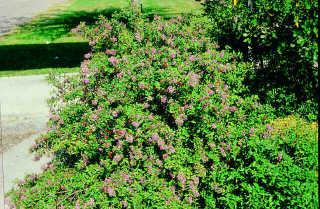
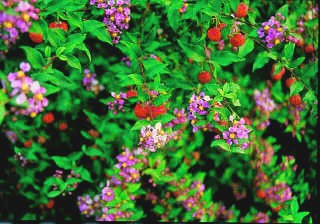
|
Heart-Leafed Hibiscus, Tulipan del Monte
Hibiscus martianus, Malvaceae, Mallow Family
Description: Short, leafy shrub with large, showy,
crimson flowers
Height: To 2 ft
Flowers: Large, showy, solitary, brilliant-crimson, 2.5 inches
wide; throughout year after rainfall
Fruit: Oval capsule to 0.8 inches long, few-seeded
Foliage: Alternate, simple, to 3.2 inches long and wide, broadly
oval to weakly lobed, green, weakly toothed
Spines: Unarmed
Bark: Smooth greenish-brown with white pin-head sized elongated
spots
Growth Rate: Slow
Requirements:
Sun: Usually in partial shade protected by spiny shrubs
Soil: Gravelly, caliche, others
Drainage: Well
Water: Low, drought tolerant
Maintenance: None
Propagation: Fresh seed, softwood cuttings
Native Habitat: Chaparrals, matorral,
thornforests
Wildlife Use:
Leaves - caterpillars of Columella Hairstreak and Western
Checkered Skipper eat Hibiscus leaves but are not recorded from
this species
Comments: Long known as Hibiscus cardiophyllus;
inconspicuous until it flowers, one of the most spectacular
native flowers
|
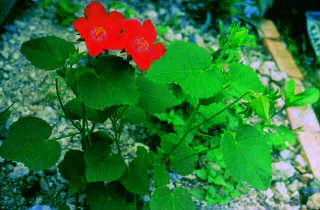 |
Drummond's Turk's Cap, Manzanilla
Malvaviscus drummondil, Malvaceae, Mallow Family
Description: Large, often vine-like shrub with large,
lobed leaves and long, vermilion-red flowers
Height: To 10 ft, usually 2 to 5 ft.
Flowers: Solitary, vermilion-red petals do not spread, to 1.4
inches long, reproductive parts extend from within; throughout
year
Fruit: Bright-red, 5-seeded, berry-like, edible, turban-shaped
Foliage: Simple, alternate, large, 3-lobed, 2-4 inches long and
wide
Spines: Unarmed Bark: Smooth, greenish to light-brown with light-brown
pin-head sized spots
Growth Rate: Medium
Requirements:
Sun: Partial shade to full sunshine
Soil: Many, loamy, sandy
Drainage: Medium
Water: Medium
Maintenance: Keep from over running other shrubs
Propagation: Seed
Native Habitat: Mesic woodlands and palm groves
Wildlife Use:
Fruit - many birds and mammals
Nectar - hummingbirds, butterflies
Leaves - caterpillars of Glassy-winged Skipper
Comments: Very attractive to butterflies and birds
|
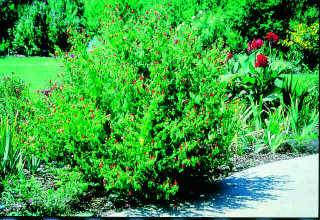
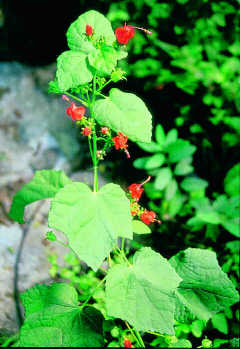
|
Black Brush,
Chapparo Prieto
Acacia rigidula, Mimosaceae, Mimosa Family
Description: Several-stemmed, rigid-branched, large
shrub with dark leaflets and spectacular displays of creamy-white
flowers
Height: To 25 ft, usually 6 to 10 ft.
Flowers: Small, dense, creamy-white in elongate, axillary
clusters (spikes); February, reflowering sparsely later
Fruit: Linear, reddish-brown to black pods, to 3.2 inches long,
open and drop seed
Foliage: Dark-green leaflets, few per leaf, alternate
Spines: Paired, white, straight, spines to 1.1 inch long, at
nodes
Bark: Whitish to light-gray, smooth, and tight
Growth Rate: Slow to medium
Requirements:
Sun: Full sun to partial shade
Soil: Sandy loams, calcareous, gravelly, caliche
Drainage: Well
Water: Low, drought tolerant
Maintenance: None
Propagation: Seed
Native Habitat: Chaparrals, thornforests
Wildlife Use:
Nectar - bees, butterflies
Leaves - White-tailed Deer, Cattle
Seeds - Northern Bobwhite
Nest sites, cover
Comments: Similar in appearance to small Texas Ebony
and often confused with it in chaparrals unless pods found
|
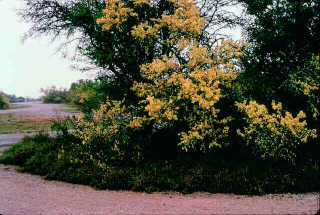
|
Sierra Madre Torchwood,
Amyris madrensis, Rutaceae, Citrus Family
Description: Small, slender, leafy, pretty tree
Height: To 18 ft, usually 6 to 10 ft.
Flowers: Small, inconspicuous, white to greenish, perfect; Spring
to Autumn
Fruit: Linear, Ovoid drupe, ripening black
Foliage: Shiny, attractive, compound, leaflets wavy-margined,
leathery, rhombic, 5-9 pairs plus terminal leaflet, crushed
leaflets have citrus scent
Spines: Unarmed
Bark: Mottled, light-to-dark-gray
Growth Rate: Medium
Requirements:
Sun: Usually in shade in understory, growing towards light
Soil: Loamy
Drainage: Well
Water: Low, drought tolerant
Maintenance: None
Propagation: Seed, softwood cuttings
Native Habitat: Subcanopy of tall thornscrub,
thickets
Wildlife Use: None reported
Comments: One of most attractive native foliages in LRGV; freeze-hardy to
20.5 F; the wood ignites easily, hence the
generic name of torchwood
|
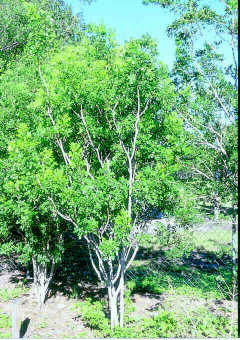 |
Chapotillo, Texas Torchwood
Amyris texana, Rutaceae, Citrus Family
Description: Attractive, green, compact in shade,
woodier, fewer leafed in full sun Height: To 6 ft
Flowers: Small, greenish-white, aromatic, clustered in terminal
panicles; Spring to Fall, perhaps longer
Fruit: Small, globose, black, fleshy drupes
Foliage: Evergreen, shiny, trifoliate, aromatic (citrus-scented)
Spines: Unarmed
Bark: Mottled-gray, roughened, often lichen-coated
Growth Rate: Medium
Requirements:
Sun: Shade to full sun
Soil: Loamy, sandy, other types
Drainage: Well-drained
Water: Low, drought tolerant
Maintenance: None
Propagation: Seed, fresh or dried up to 1 year; softwood cuttings,
with rooting hormone
Native Habitat: Understory of mesic woods, Ebony
Woodland, to dry chaparral
Wildlife Use:
Fruit - variety of birds
Leaves - Giant Swallowtail caterpillars, White-tailed Deer
Comments: Members of the genus are lumped under the generic
term, torchwood, because the wood ignites easily; forms buds and
awaits rainfall, then the buds open quickly
|
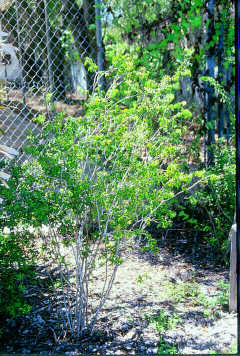
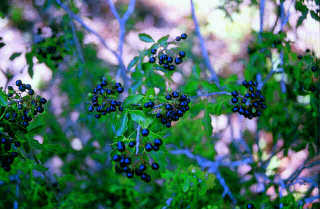
|
Cenizo, Texas Ranger, purple sage
Leucophyllum frutescens, Scrophulariaceae, Figwort Family
Description: Much-branched shrub with dense, ashy-gray
foliage and purple flowers after showers
Height: To 12 ft, usually 5 to 8 ft.
Flowers: Showy, solitary, axillary, pale-violet to purple, white
and pink cultivars; appear quickly after rainfall throughout year
Fruit: Dry, 2-valved capsules
Foliage: Evergreen, simple, alternate or clustered, ashy-gray,
elliptic, untoothed leaves
Spines: Unarmed
Bark: Grayish-black to aging black and roughened with small
scales
Growth Rate: Fast
Requirements:
Sun: Prefers full sun, green forms do occur rarely in shade
Soil: Caliche, sandy, gravelly, arid
Drainage: Well
Water: Low, drought tolerant, green forms are more water tolerant
Maintenance: Cotton root rot problem, do not fertilize, shade
causes cultivars to grow leggy
Propagation: Seeds, cuttings
Native Habitat: Chaparrals, caliche and gravel
ridges
Wildlife Use: Leaves - caterpillars of Theona
Checkerspot
Comments: Green forms, naturally found in Cameron Co.,
will withstand irrigation and maintain foliage from ground level
up
|
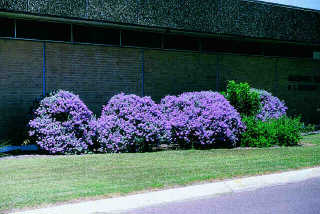
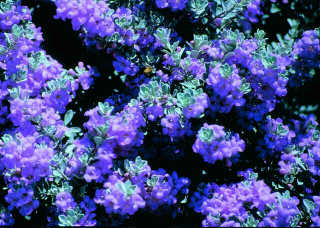
|
Chilipiquin, Bird Pepper
Capsicum annum, Solanaceae, Nightshade Family
Description: Broad-spreading, round top, green,
zigzagging twigs bearing many small, white flowers followed by
small, red peppers
Height: To 7 ft, usually half that
Flowers: Small, white, solitary or in pairs, 0.3 inches wide;
throughout year
Fruit: Small-red (ripe), pungent peppers
Foliage: Simple, alternate, oval leaves with smooth edges or with
tiny teeth, dull-green above, paler below, to 1.5 inch long
Spines: Unarmed
Bark: Green to light-brown
Growth Rate: Fast
Requirements:
Sun: Naturally in partial shade, to full sun
Soil: Loamy
Drainage: Medium
Water: Medium
Maintenance: Little
Propagation: Seeds
Native Habitat: Riparian woodland, mesquite-granjeno
woods, chaparrals
Wildlife Use:
Fruit - Wild Turkey, Northern Mockingbird
Comments: All peppers are cultivars of this species
|
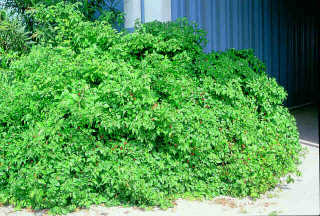
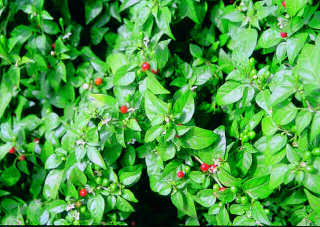
|
White Brush,
Chaparro Blanco
Aloysia gratissima, Verbenaceae, Verbena Family
Description: Slender, aromatic, much-branched shrub
with long spikes of white flowers
Height: To 15 ft, usually half that
Flowers: Numerous, small, tubular, white flowers in terminal,
elongate clusters (spikes); following rainfall any time of year
Fruit: Small, dry, two nutlets enclosed in calyx
Foliage: Simple, opposite, drought-deciduous, shape varies with
moisture received, vanilla-scented,usually toothless
Spines: Unarmed
Bark: Tan or gray, young twigs four-sided
Growth Rate: Fast, pioneer species in abandoned farm fields
Requirements:
Sun: Full sun to partial shade
Soil: Various, poor, sandy, caliche, gravelly
Drainage: Well
Water: Low, drought tolerant
Maintenance: Pruning back results in more flowers and more
compact growth
Propagation: Seed, cuttings
Native Habitat: Gravelly hills, chaparrals,
thickets, woodlands
Wildlife Use:
Nectar - bees, butterflies
Leaves - Cattle, Sheep, Goats Cover
Comments: An attractive ornamental profusely flowering
in landscapings
|
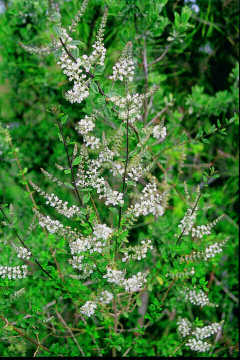 |
Tamaulipan Fiddlewood,
Negrito
Citherexylum berlandieri, Verbenaceae, Verbena Family
Description: Crooked shrub or small, gnarled tree with
numerous white tubular flowers followed by long persistent fleshy
fruit
Height: To 27 ft, usually 6 to 10 ft.
Flowers: White, small, tubular, densely clustered (racemes) near
tips, February through Summer
Fruit: Persistent, 2-seeded, shiny, fleshy, yellow to red to ripe
black
Foliage: Deciduous, simple, opposite or crowded, lance-head
shaped, yellow-green, darker above, toothless or few-toothed near
tip
Spines: Unarmed
Bark: Mottled-gray, smooth and tight
Growth Rate: Fast
Requirements:
Sun: Full Soil: Clay, others
Drainage: Medium
Water: Medium
Maintenance: Little
Propagation: Ripe seed
Native Habitat: Clay lomas, thickets, palm
groves
Wildlife Use: Fruit - birds Nest sites and cover
Comments: Attractive leaves, flowers, fruit on specimen
shrub
|
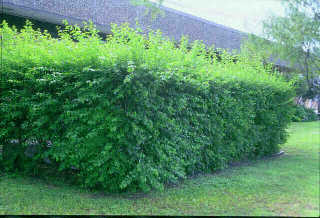
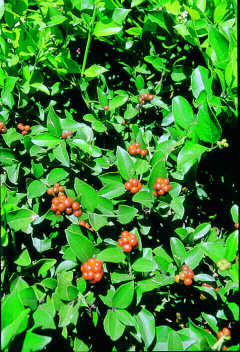
|
Texas Lantana,
Hierba de Cristo
Lantana horrida, Verbenaceae, Verbena Family
Description: Low, much-branched, wide-spreading,
aromatic, with showy heads at branch tips
Height: To 6 ft, usually half that
Flowers: Many-flowered, rounded heads of short, tubular, red,
orange, and yellow flowers; March to December
Fruit: Fleshy, edible, black or dark-blue, containing 2 nutlets
Foliage: Simple, opposite, toothed, oval leaves, dark-green above,
paler beneath
Spines: Occasionally prickly
Bark: Gray or brown
Growth Rate: Fast
Requirements:
Sun: Full sun to partial shade
Soil: Best in sandy, loamy
Drainage: Well
Water: Low, drought tolerant
Maintenance: Little
Propagation: Seed, root partitions, or cuttings
Native Habitat: Clay lomas, resaca banks, scrub,
old fields, thickets, swamps, rich sandy woods, gravelly hills,
chaparrals, roadsides
Wildlife Use:
Nectar - hummingbirds, butterflies
Fruit - Northern Bobwhite, Greater Kiskadee, Northern Mockingbird,other
birds
Leaves - Painted Lady caterpillars use some Lantanas
Comments: Poisonous to livestock
|
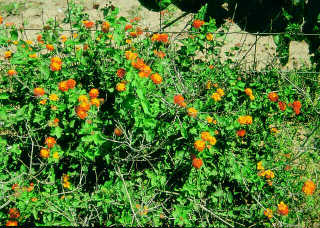
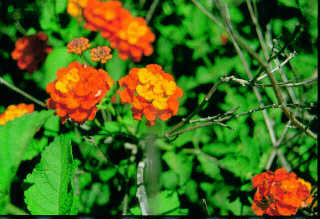
|
Desert Lantana,
Hierba Negra or Negrita
Lantana macropoda, Verbenaceae, Verbena Family
Description: Short, slender, densely pubescent, erect
shrub with attractive white flowers
Height: To 3 ft Flowers: In rounded, dense heads, short tubular,
white or pink with yellow centers; after rainfall throughout year
Fruit: Thin-fleshed, fruit splits into two 1-seeded nutlets
Foliage: Simple, opposite, deciduous, long-oval, aromatic blades
to 1.75 inches long
Spines: Unarmed
Bark: Gray or brown
Growth Rate: Medium
Requirements:
Sun: Full sun
Soil: Gravelly, caliche
Drainage: Well Water: Low, drought tolerant
Maintenance: None
Propagation: Seed, root partitions, or cuttings
Native Habitat: Chaparrals, grasslands,
fencerows, gravelly hillsides, deserts
Wildlife Use:
Leaves and fruits browsed by White-tailed deer
Leaves - caterpillars of Gray Hairstreak, Painted Lady
caterpillars use some Lantanas
Nectar - butterflies
Comments: Short, often-flowering, and attractive to
butterflies
|
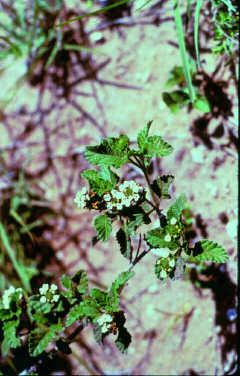
|
Oregano, Redbud Lippia
Lippia graveolens, Verbenaceae, Verbena Family
Description: Short, slender, erect, aromatic shrub with
small heads of creamy-white flowers
Height: To 3 ft rarely (30 ft)
Flowers: Fragrant, short tubular in short cluster (spikes),
creamy-white to yellowish with yellow centers; throughout year
after rainfall
Fruit: Dry fruit, splits into 2 nutlets
Foliage: Simple, opposite, deciduous; blades oblong, green, to 2.5
inches long
Spines: Unarmed
Bark: Light brown
Growth Rate: Medium
Requirements:
Sun: Full sun
Soil: Caliche, gravelly, loamy, rocky
Drainage: Well
Water: Low, drought tolerant
Maintenance: None
Propagation: Seed, root partitions, or cuttings
Native Habitat: Chaparrals, open desert scrub,
roadsides
Wildlife Use: Leaves - White-tailed Deer,
caterpillars of Bazochi Hairstreak Nectar - butterflies
Comments: Short, often-flowering, and attractive to
butterflies
|
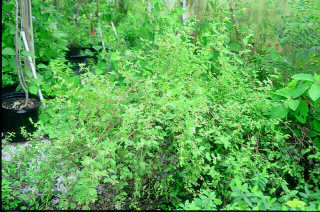
|
FURTHER READING
Everitt, James H., and D. Lynn Drawe. 1993. Trees,
Shrubs & Cacti of South Texas. Texas Tech University Press,
Lubbock. 213 pp.
Ideker, Joe (ed.). 1984-on. The Sabal, vol. 1- on. [a
publication the NPP dedicated to the native plants of the Lower
Rio Grande Valley, Texas].
Ideker, Joe. 1994. Checklist of Woody Plants Native to the
Lower Rio Grande Valley of Texas, 1989 revision. The Sabal 11 (1):
2-6.
Lonard, Robert I., James H. Everitt, Frank W. Judd, with
Norman A. Browne. 1991. Woody Plants of the Lower Rio Grande
Valley, Texas. Texas Memorial Museum, University of Texas at
Austin., Misc. Publ. No.7. 179 pp.
Miller, George O. 1991. Landscaping with Native Plants of
Texas and the Southwest. Voyager Press, Stillwater, MN. 128 pp.
Native Plant Project. 1994. Native Trees of the Lower Rio
Grande Valley, Texas. Landscape Uses and Identification. Native
Plant Project, Edinburg. 37pp.
Nokes, Jill. 1986. How to Grow Native Plants of Texas and the
Southwest. Gulf Publishing, Houston. 404 pp.
Vines, Robert A. 1960. Trees, Shrubs, and Woody Vines of the
Southwest. University of Texas Press, Austin. 1104 pp.
Wasowski, Sally 1995. Native Gardens for Dry Climates. Crown
Pub. Group. 210 E. 50th, New York, NY 10022.
Wasowski, Sally, and Andy Wasowski. 1994. Gardening with
Native Plants of the South. Taylor, Pub. Co. Dallas, TX. 208pp.
Wasowski, Sally, and Julie Ryan. 1985. Landscaping with Native
Plants: Landscaping Region by Region. Texas Monthly Press, Austin.
Wasowski, Sally with Andy Wasowski. 1988, 1991. Native Texas
Plants: Landscaping Region by Region. Texas Monthly Press, Austin.
406 pp.
Produced by The Native Plant Project
Printed by Gateway Printing, Edinburg, TX
Printed on recycled paper using environmentally friendly ink
THE NATIVE PLANT
PROJECT
of the Lower Rio Grande Valley
The Native Plant Project currently holds general meeting
eight times per year. Members are advised of meetings, field
trips, and other activities through The Sabal, which conveys
information on the native plants, habitats, and the environment
of the Lower Rio Grande Valley, Texas. The Native Plant Project
periodically updates and issues lists of endangered species of
the Lower Rio Grande Valley and checklists of its woody plants.
Native Plant Project
P. O. Box 2742
San Juan, TX 78589
Acknowledgment
The Native Plant Project wishes to thank it's Board members for
producing this handbook.
|













































